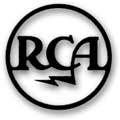
RCA
Victor A-20
"Globetrotter"
1940
Made in Montreal, Canada
by RCA Victor Company Ltd.
 |
RCA
Victor A-20 1940 |
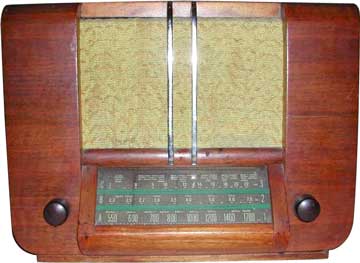
Yet another eBay win, aquired in March 2002. (for Cdn$127.96 / US$81.00 from a seller in Richmond Hill, Ontario - yeah, I went nuts in the bidding) I'd been looking for one since I saw one at the Bayhead Radio Museum last year, or maybe it was when I saw the one with red grille cloth, earlier on eBay (see below). These photos were originally from the sellers' listing. They don't show any cleaning or refinishing yet.
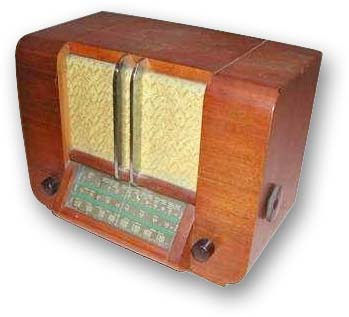
I had heard (somewhere) that this cabinet was designed by Art Deco designer and illustrator John Vassos (1898-1985), but I cannot confirm that yet. (update: Mark Stein attributes it to John Vassos, in his book Machine Age to Jet Age, Vol.I and it was somewhere in the Antique Radio Forum that I read it.)
The RCC data sheet/schematic for this set is found in the Canadian General Electric 1940 series, as model JK53, "CGE Data Sheet 43A" in the index, but on the data sheet itself it's numbered simply "C.G.E. 43". NostalgiaAir has a fairly good scan of the schematic, as a black and white GIF image, 2550 x 3302 pixels, 207 kB.
The tuning knob on the right side has a little dimple in it, so you can spin it with a fingertip. There's a similar knob on the left side for the tone control, but without the dimple. The front left knob is for on/off/volume, and the front right one is the band switch.
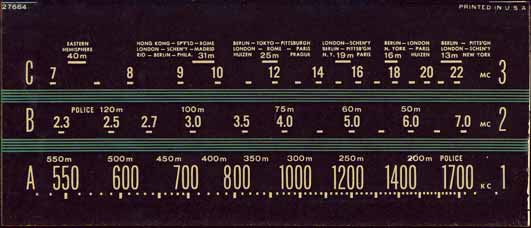
The dial glass, at 75 dpi, scanned with a black felt background. The actual background on the radio is more of a greenish-gold velvet. The lettering and green lines are printed on the back of the glass, and are waterproof so I was able to get it fairly clean with paper towels and water. Here's a larger version, at 150 dpi. If you need it, I can email a 300 dpi scan, black on a white backround.
Before I cleaned the dial glass, I tested it by wiping the part number in the upper left corner (which does not show when it's installed) with a damp cloth. Then I put a drop of water on the part number and let it sit there for 5 minutes, before I wiped it again. I did the same thing on some of the green lines at one end. Sometimes the lettering on a dial glass is water-soluble, and it may take a few minutes to soften up. If you just go ahead and start rinsing, it may be too late to stop, and your dial glass is ruined. In this case it did not smear, so I rinsed it under running water and carefully wiped it with a rag and paper towels. No window cleaning solution! There were also a few tiny spots of varnish or something on the unprinted front of the glass, but I was able to scrape them off with a sharp X-Acto knife, under a magnifying glass.
| serial number |
3131
|
| power requirements |
105/125 volts AC, 60 Hz
|
| IF frequency |
455 kHz
|
| height width depth |
10.5"
13.5" 8" |
| Band C Band B Band A |
7 - 22 MHz 2.3 - 7.0 MHz 550 - 1700 kHz |
|
antenna |
external |
|
Tube complement
|
|
|
1st Det and Osc
|
6SA7
|
|
I.F
|
6SK7
|
|
2nd Det. AVC & Audio
|
6SQ7
|
|
Output
|
6F6G
|
|
Rectifier
|
5Y4G
|
At the back of the chassis is an RCA phono input and a switch, labeled "Television or Record". Good thing it was forward-compatible.
It also has an AC receptacle (for the TV or phonograph, I guess) but the one on mine is for a two-prong polarized plug, which has me wondering. I didn't think they were in wide use back then, but maybe it was a modern replacement. The cord itself has a non-polarized two-prong plug, but that may not be original either.
October 24, 2002 - I've discovered a bit of a mystery about the A-20. I've seen photos of several of them, and each one has a different grille cloth.
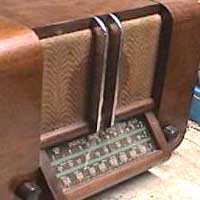 |
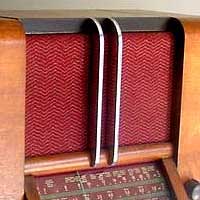 |
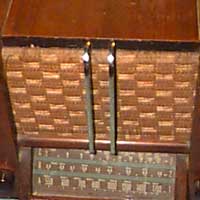 |
|
Chris Fanjoy, (near Moncton, New Brunswick) was kind enough
to provide this photo of his. It looks to me like a wave pattern, similar
to the one sold by Antique Radio Grille Cloth as Zenith
pattern #28 , suitable for 1939 models.
|
Tim Sullivan (El Paso, Texas) won this set on eBay a year
or two ago. I appropriated the photo from the seller's auction page. I
think the red is the sharpest looking cloth, with a bit of herringbone
or zig-zag pattern.
I really should write Tim and ask if he can tell if it's factory original cloth or not. |
Joanne Wyatt (Red Deer, Alberta) gives this description:
"The grille cloth on my radio is brown plus it has some wee lines which
are a lighter color." The serial number is 675.
|
Unfortunately, I don't recall the colour of the cloth on the one at the Bayhead Radio Museum, but it does look sorta beige/greyish/brownish. Not red or yellow, at any rate.
I plan to keep browsing microfilm archives of newspapers from that period, hoping to find any reference to grille cloth colour. I didn't find any in Toronto papers, but perhaps Montreal papers would have more RCA ads. Maybe there was a choice of colours, or maybe they changed it depending on the season and/or availability.
If you have an A-20 with grille cloth like any of these above, please drop me a line. If yours is different from them, send me a photo or scan of the cloth (a closeup would be best), and the serial number too.
Joanne Wyatt also found this article at the Radio Attic - A Restored Gem from Canada - CGE's JK53 The Canadian General Electric model JK53 uses the same chassis as the RCA A-20, and you can see the family resemblance in the photos.
Back to John Rose's Vintage Radio Home
Back to my Wood Radios